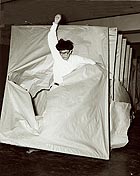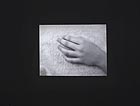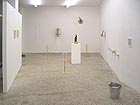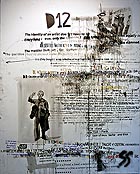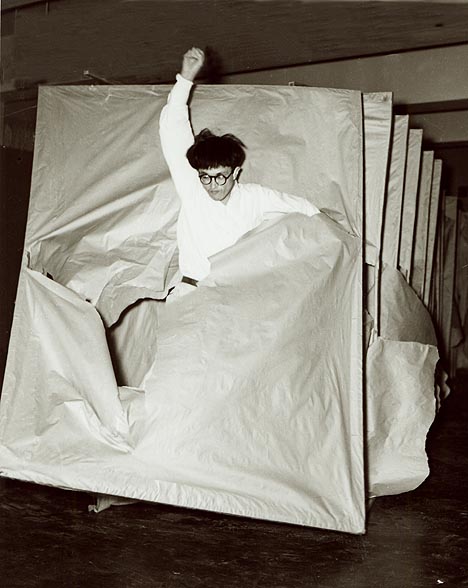
translated and summarized by: Liz Wollner-Grandville,
English summaries March 22 - April 3
MUMOK Museum of Modern Art
Direct Art - Viennese Actionism in an international context
12.11.10 - 29.05.11
Strangulation and bulky waste
In Günter Brus' book "Good Old Vienna", the Viennese Actionist, Otto Mühl, is simply called "Otto Bulky Waste". When you come to think of it, bulky waste stands around getting in the way and waiting to be disposed of. This can certainly not be said of Otto Mühl. The MUMOK places his work in the centre of the real sequence of collection exhibitions of Viennese Actionism. The show "Direct Art" has gathered pieces from the 1950's and 1960's, which belong to the house's collection and now present them in a new context. These are meant to be international, but however, the spectrum remains relatively limited: The Japanese Saburo Murakami broke into reality from canvases in 1956 and also the well-known art expansions into the real focus of that era are represented: Nouveaux Realists, Spoerri, Beuys, Warhol – the latter with a wonderful video study of a woman's face. Latin American art or other such body-oriented, truth-oriented and conceptual-oriented exotica aligned to Actionism are not to be expected.
At their first international appearance, the Viennese Actionists called themselves "The Vienna Institute for Direct Art". That was at the "Destruction in Art Symposium" in 1966 in London and justifies the appropriate title of today's exhibition. The conceptualistic side of the art destruction is just as tentatively represented as its feministic effect (VALIE EXPORT and Carolee Schneemann have the space that they deserve but the exhibition brochure, on the other hand, shows ten pictures of artistic production, not one of which is of a woman).
And yet the concept of the exhibition is a success, the quality of the works cannot be questioned. Alone, the emphasis has to evoke doubt. In the political art of the 1960's, Mühl's portraits of the politicians could easily be ignored – in any case, Wolf Vostell's works can make up for this. And finally, Mühl's materiel battles appear particularly coarse and exactly in opposition to the works on, and with, the bodies of Brus: whilst Mühl handles women's bodies just as risk-free as other everyday objects, Brus makes himself vulnerable and sensitive - not only in a figurative sense (not only in "Strangulation" 1968). The difference in the crass gestures is like that between the Punks and the Rockers - an all or nothing.
It would be the task of an art historian to find a distanced attitude to the entire Mühlistic malpractice. And until this happens, we will have to make do with the Brus synthesis of contemporary witness and corny jokes.
By Jens Kastner
MUMOK Museum moderner Kunst
1070 Vienna, Museumsquartier, Museumsplatz
Tel: +43 1 52 500
Fax: +43 1 52 500 13 00
Email: info@mumok.at
www.mumok.at
Opening hours: daily 10 a.m. – 6 p.m., Thu: 10 a.m. – 8 p.m.
Galerie mezzanin
Marzena Nowak
16.03.11 – 30.04.11
In Morpheus arms
In her second solo exhibit at the Galerie mezzanin in Vienna, the young Polish artist Marzena Nowak presents conceptual art strategies employed to modify physical and mental experiences. Nowak’s works are currently also being shown at the Salzburger Kunstverein.
Upon entering the small front room in the Galerie mezzanin the visitor is confronted with a piece of carpet positioned in the middle of the floor like a paper pattern. Along the wall are wooden ledges, similar to handrails that function like a body-repellent, protecting the white wall from human contact. Nowak’s entrance area radiates both cosiness and desolation, yes, even coldness. Everything has its place, but on account of its barrenness, one does not feel like staying. The room constitutes an entre where one can brush off the outside world.
In the gallery’s main room there are different sized canvases marked with fine pencil lines creating grids that have been systematically painted with colour triangles. Here the artist applies a serial, repetitive procedure that allows her to use colour as an emotional form of expression or simply to ascribe certain attributes to the colour. It is a kind of mathematical system, the positioning of codes and colours that create a shimmering overall picture. Nowak achieves convincing aesthetic solutions; the subtle colourful grid structures seem to swing like sounds.
A four-minute video – “untitled, in between” – showing the transition from sleeping to awakening, is also presented. A hand rests calmly on a brick surface until it slips off. The video skilfully captured this moment of awakening, the moment of “no longer and not any more”. Similar to the images on canvas, the video predominantly deals with – feminine – experiences of an everyday rhythm reminding of summer afternoons behind dark drapes. Marzena Nowaks’s main topics are the visualisation of emotions and their quality structure in space and time, and she is successful in finding a visual language to do so.
By Susanne Rohringer
Galerie mezzanin
1010 Vienna, Getreidemarkt 14/corner Eschenbachgasse
Tel: +43 1 526 43 56
Fax:+ 43 1 526 91 87
Email: mezzanin@chello.at
www.mezzaningallery.com
Opening hours: Tue-Fri Noon – 6 p.m. , Sat 11 a.m. – 2 p.m.
COCO (Contemporary Concerns)
Juozas Laivys – 1409m
18.03.11 - 17.04.11
Buoyant sources
Many Viennese graciously whine about other Viennese who also whine; but there's hardly any Viennese who don't praise the quality of the mountain spring water which flows out of the city's taps and on its way, creates 65 million kilowatt hours of energy - enough electricity for a small city.
Number 6 of the concretely poetical work in the recently opened exhibition of the Lithuanian artist, Jouzas Laivys in the Coco, is called Penguin in Viennese Water" - in the globally understandable variation, "Viennese" is replaced by "local", so that without a doubt, we can seriously compare it with the Viennese water. The porcelain penguin is grey, has no black tailcoat but does have a golden beak. He is situated on a mirror in a metal buck, and from below knee level his upward glance is somewhere between cute and loving, a figure hardly bigger than a hand, but which is elongated by the mirror. The Viennese water is up to the porcelain animal's neck, he looks as if he is enjoying himself and the water is invisible above the mirror.
Further invisibilities can also be found - for instance, in Number 16, presented as "Painting by Valdas Simutis, behind whom a book with mushroom recipes is hidden". The picture, which is attached to the wall on the left-hand side of its frame, protrudes in a generous abstract-minimalistic way into the room. It depicts a man in a green light with a basket full of mushrooms; he is wearing practical boots and a peaked cap and gazes admiringly at a mushroom in his hand. The painting is unsullied by cubism and other bare-knuckled innovations, but the mushrooms have absorbed a red tone and one would truly like to know which recipe could produce this - but it, and the book it is in, are hidden - invisible. Beside it, Number 15 hangs a little higher, "A bad job". A piece of wood is decorated with small flakes of horn - one could almost say "antler sausages" and an antler-like longer branch in the middle. It's not a stag's antlers and it's not an obelisk. It's a "bad job" whose woody phallus-like humor surprises one.
Thrice represented are "Shooing Away Lurking Moles” (Lauernde Maulwurfsscheuchen) that consist of three large plastic bottles whose yellow caps are wound around simple wooden stands, which are cut into the windows. Duchamp would have been pleased and the moles are obviously enjoying themselves too - the devices are enormously suited as a mole sun studio. Altogether, there are 23 works on the exhibition list, amongst them four collaboration products. Two of these were performances on the opening evening - an exchange of air, performed by Reda Aurylaitè and installed in the second room, and a coin collector in the collection, performed by Gytis Daukas.
In terms of the city's age, the luxury of the public water supply has been quite short. The Viennese water is delicious. In coffee houses, it is served (mostly) cost-free by friendly waiters. It is a luxury to be able to muse about things that, as a matter of fact, one encounters on a daily basis with such luxurious serenity.
By Gesche Heumann
COCO (Contemporary Concerns)
1010 Vienna, Bauernmarkt 9 (Passage)
email: coco@co-co.at
www.co-co.at
Opening hours: Exhibition: Thu - Sat 4 p.m. – 8 p.m. Bar: Thu – Sat 6 p.m. – 2 a.m.
Galerie Krobath
Despina Stokou
16.03.11 – 30.04.11
No longer a language
Galerie Krobath stands out among the many galleries in Vienna’s Eschenbachgasse with its exhibition of works by the young Greek artist Despina Stokou.
Stoukou, who lives in Berlin since 2002, enjoyed a global education and attended the German school in Athens. In Berlin she is linked with numerous “off spaces” and repeatedly curates exhibitions. She considers herself an “artator” (artist-curator) and believes that creativity, self-organization and (self) marketing are in no way compatible. Here in Vienna, Stokou limits herself to her artistic work and mainly displays large-format panel paintings that developed from collages. These rather dark paintings with their gestural brush strokes serve as a picture carrier for the enlarged Arial and Helvetica letters that sometimes form sentences but don’t make sense, and that are glued onto them. This is obviously not meant to be a narration or a report it is more of a jungle of information and quotations through which Stokou leads us. Stokou uses Google for her research, she pursues certain topics and presents the results unsorted and jumbled. Stokou presents the concurrent flood of information and data that overwhelms all of us, with the quotations often no longer being legible. The works convey a certain expressivity and speed, however, this is not characteristic for her developmental process. On the contrary, in order to achieve this effect, Despina Stokou sometimes takes 20 to 30 days to transcribe and cut-out the texts. But since cutting an “S” turned out to be too complicated, this letter no longer exists in Stokou’s repertoire.
In Stokou’s work, the use of words (scriputalisation) is not only a self-assertion as an artist, but also as a curator and as a human being. In any case, the content of her analysis is not meant to be comprehensible to the viewer; only hints and insinuations are offered - a balancing act between disclosing and covering, between showing and hiding. Maybe this is especially important for an artist dealing with the 21st century’s flood of information. Ultimately, it can only be a step towards another artistic path.
By Susanne Rohringer
Galerie Krobath
1010 Vienna, Eschenbachgasse 9
Tel.: 0043 1 585 74 70
Fax: 0043 1 585 74 72
Email: office@galeriekrobath.at
www.galeriekrobath.at
Opening hours: Tue – Fri 11a.m. – 6 p.m., Sat 11 a.m. – 3 p.m.
Mehr Texte von translated and summarized by: Liz Wollner-Grandville


 Teilen
Teilen

